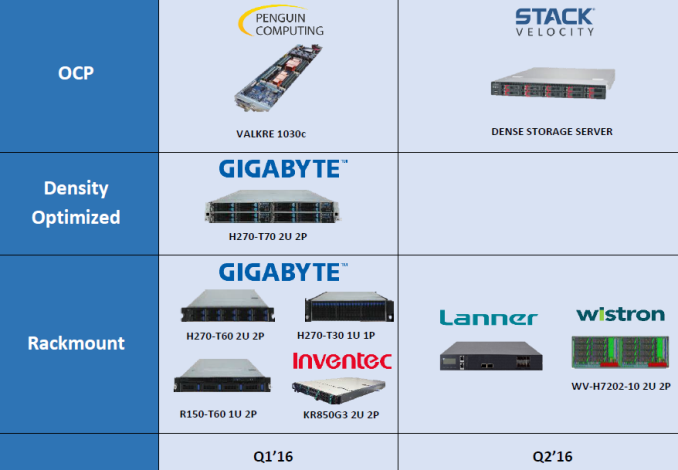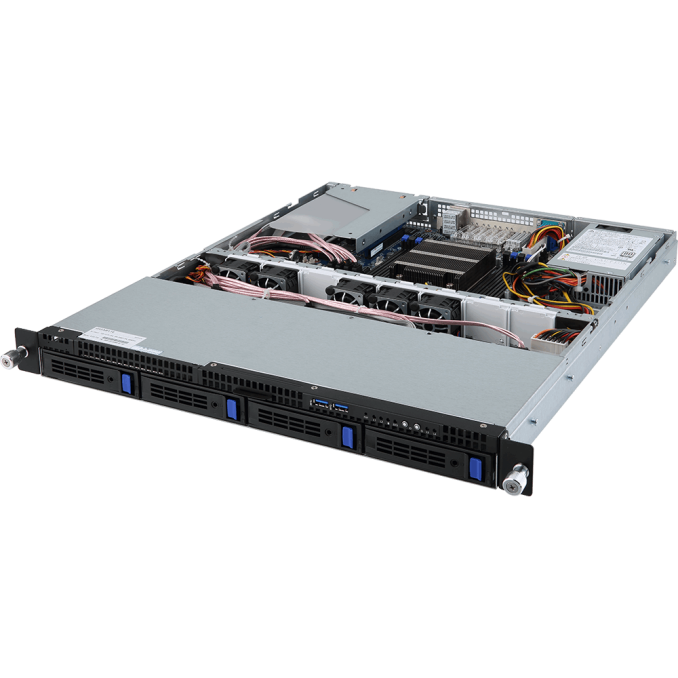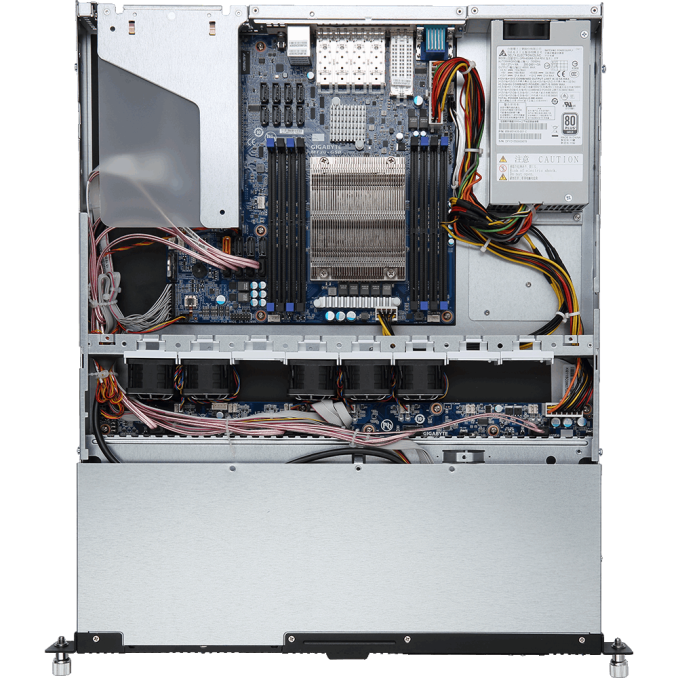Investigating Cavium's ThunderX: The First ARM Server SoC With Ambition
by Johan De Gelas on June 15, 2016 8:00 AM EST- Posted in
- SoCs
- IT Computing
- Enterprise
- Enterprise CPUs
- Microserver
- Cavium
Xeon D vs ThunderX: Supermicro vs Gigabyte
While SoC is literally stands for a system on a chip, in practice it's still just one component of a whole server. A new SoC cannot make it to the market alone; it needs the backing of server vendors to provide the rest of the hardware to go around it and to make it a complete system.
To that end, Gigabyte has adopted Cavium's ThunderX in quite a few different servers. Meanwhile on the Intel side, Supermicro is the company with the widest range of Xeon D products. 
There are other server vendors like Pengiun computing and Wistrom that will make use of the ThunderX, and you'll find Xeon D system from over a dozen vendors. But is clear that Gigabyte and Supermicro are the vendors that make the ThunderX and Xeon D available to the widest range of companies respectively.
For today's review we got access to the Gigabyte R120-T30.
Although density is important, we can not say that we are a fan of 1U servers. The small fans in those systems tend to waste a lot of energy.
Eight DIMMs allow the ThunderX SoC to offer up to 512 GB, but realistically 256 GB is probably the maximum practical capacity (8 x 32 GB) in 2016. Still, that is twice as much as the Xeon D, which can be an advantage in caching or big data servers. Of course, Cavium is the intelligent network company, and that is where this server really distinguishes itself. One Quad Small Form-factor Pluggable Plus (QFSP+) link can deliver 40 GB/s, and combined with four 10 Gb/s Small Form-factor Pluggable Plus (SFP+) links, a complete ThunderX system is good for a total of 80 Gbit per second of network bandwidth.
Along with building in an extensive amount of dedicated network I/O, Cavium has also outfit the ThunderX with a large number of SATA host ports, 16 in total. This allows you to use the 3 PCIe 3.0 x8 links for purposes other than storage or network I/O.
That said, the 1U chassis used by the R120-T30 is somewhat at odds with the capabilities of ThunderX here: there are 16 SATA ports, but only 4 hotswap bays are available. Big Data platforms make use of HDFS, and with a typical replication of 3 (each block is copied 3 times) and performance that scales well with the number of disks (and not latency), many people are searching for a system with lots of disk bays.
Finally, we're happy to report that there is no lack of monitoring and remote management capabilities. A Serial port is available for low level debugging and an AST2400 with an out of band gigabit Ethernet port allows you to manage the server from a distance.













82 Comments
View All Comments
silverblue - Thursday, June 16, 2016 - link
I think AMD themselves admitted that the Opteron X1100 was for testing the waters, with K12 being the first proper solution, but that was delayed to get Zen out of the door. I imagine that both products will be on sale concurrently at some point, but even with AMD's desktop-first approach for Zen, it will probably still come to the server market before K12 (both are due 2017).junky77 - Thursday, June 16, 2016 - link
still, quite strange, no? AMD is in the server business for years. I'm not talking about their ARM solution only, but their other solutions seem to be less interesting..silverblue - Thursday, June 16, 2016 - link
I am looking forward to both Zen and K12; there's very little chance that AMD will fail with both.name99 - Wednesday, June 15, 2016 - link
" It is the first time the Xeon D gets beaten by an ARM v8 SoC..."The Apple A9X in the 12" iPad Pro delivers 40GB/s on Stream...
(That's the Stream built into Geekbench. Conceivably it's slightly different from what's being measured here, but it delivers around 25GB/s for standard desktop/laptop Intel CPUs, and for the A9 and the 9" iPad's A9X, so it seems in the same sort of ballpark.)
aryonoco - Thursday, June 16, 2016 - link
Fantastic article as always Johan. Thank you so much for your very informative articles. I can only imagine how much time and effort writing this article took. It is very much appreciated.The first good showing by an ARMv8 server. Nearly 5 years later than expected, but they are getting there. This thing was still produced on 28 HKMG. Give it one more year, a jump to 14nm, and a more mature software ecosystem, and I think the Xeons might finally have some competition on their hands.
JohanAnandtech - Thursday, June 16, 2016 - link
Thank you, and indeed it was probably the most time consuming review ... since Calxeda. :-)Yes, there is potential.
iwod - Thursday, June 16, 2016 - link
Even if the ThunderX is half the price of equivalent Xeon, I would still buy Intel Xeon instead. This isn't Smartphone market. In Server, The cost memory and Storage, Networking etc adds up. Not only does it uses a lot more power in Idle, the total TCO AND Pref / Watts still flavours Intel.There is also the switching cost of Software involved.
And those who say Single Core / Thread Performance dont matter have absolutely no idea what they are talking about.
As far as I can tell, Xeon-D offers a very decent value proposition for even the ARM SoC minded vendors. This will likely continue to be the case as we move to 10nm. I just dont see how ARM is going to get their 20% market share by 2020 as they described in their Shareholder meetings.
rahvin - Thursday, June 16, 2016 - link
If you have to switch software on your severs because you switch architecture you are doing something wrong and are far too dependent on proprietary products. I'm being a bit facetious here but the only reason architecture should limit you is you are using Microsoft products or are in a highly specialized computing field. Linux should dominate your general servers.kgardas - Friday, June 17, 2016 - link
Even if you are on Linux, still stack support is best on i386/amd64. Look at IBM how it throws a lot of money to get somewhere with POWER8. ARM can't do that, so it's more on vendors to do that and they are doing it a little bit more slowly. Anyway, even AArch64 will mature in LLVM/GCC tool chain, GNU libC, musl libC, linux kernel etc but it'll take some time...tuxRoller - Thursday, June 16, 2016 - link
Aarch64 has very limited conditional execution support.http://infocenter.arm.com/help/index.jsp?topic=/co...